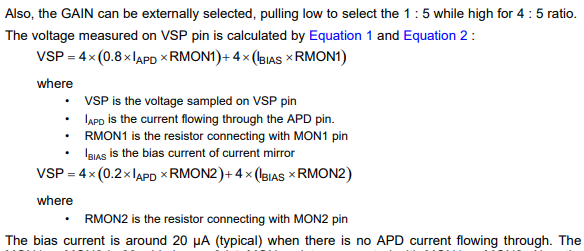Other Parts Discussed in Thread: ACF2101
The TPS61390 has built in current mirrors. You can select between two current mirrors, sample the voltage at a resistor connected to the mirror at a moment in time, and read back this voltage multiplied by 4 at some time after sampling.
The current mirror has about 20uA of bias current.

For this to be useful in an APD or MPPC, the bias current would have to be in the µA range. Is this a normal way to use MPPCs/APDs? For low light levels, I believe you can get sensitivity if bias current is in the nA range. or lower, allowing us to count pulses and compare the dark pulse count with the pulse count while sampling a light source. For larger signals, we integrate using a TI ACF2101 switched integrator. In the testing I'm doing now, I'm using a 10,000pF integration cap, integrating for 2s, to measure current in the nA range.
In what scenarios is bias current in the µA range?
A few years ago Helen chen addressed the issue of measuring the voltage at the MON pins, not using the internal 4x voltage amp.
Eric Yue touched on this issue in a response to my question, but we never got into why we would want to measure currents in the µA range.



